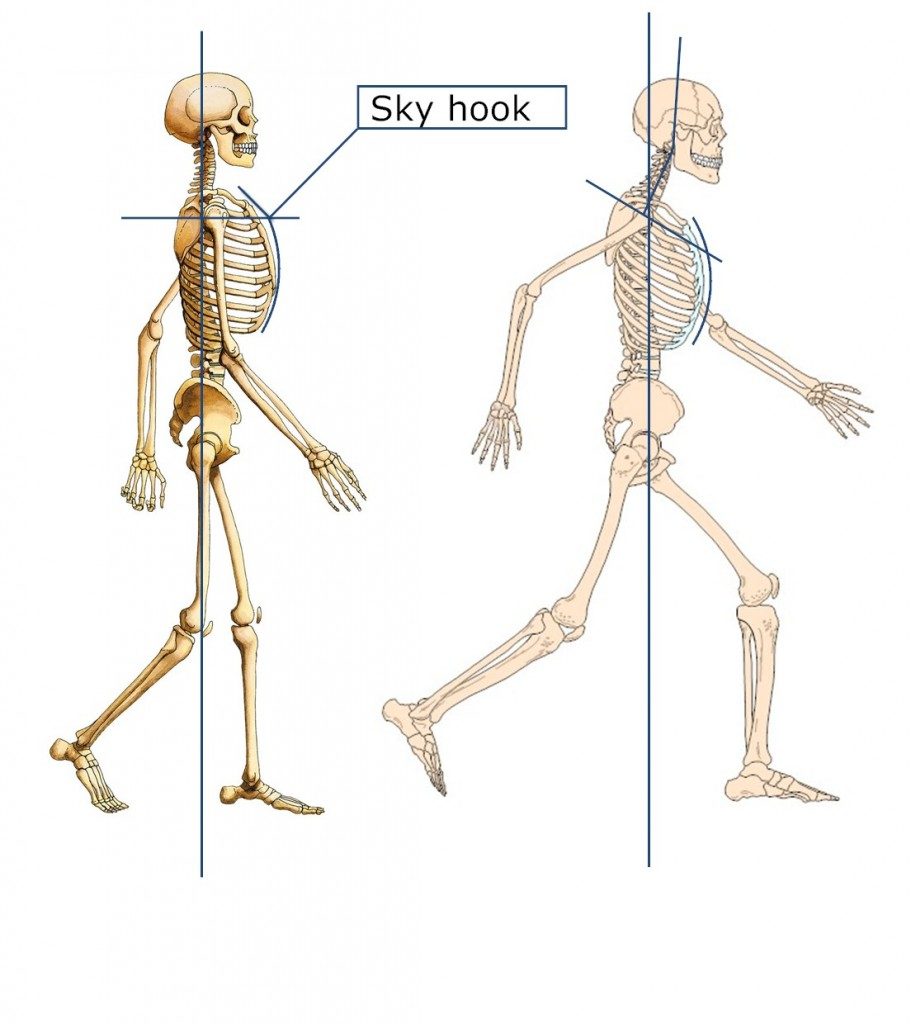INTRODUCTION
Traditionally when we want to correct our posture we think to pull our shoulders back. Doing so can temporarily straighten our back, but as soon as we defocus from this action our posture will slide back into that slumped default. If one maintains an erect posture in this way the shoulders develop a rigid “militaristic” appearance. There is a simple explanation of why pulling our shoulders back doesn’t work – the shoulder girdle is not part of our core, whereas the ribcage, neck, and head are. Using the shoulders to align the core has at best an indirect effect. There is, however, direct means to influence core alignment.
“Head Forward” posture is very common in post-industrial societies. There are many reasons for this (there is an index of related pages on the bottom of this page), and it is likely a physical expression of our cultural obsession with “getting ahead”. Looking down at a Cell Phone also contributes. Here is a list of common expressions associated with this cultural attitude:
Getting Ahead
Head Start
Making Some Headway
Over time a “head forward” posture can lead to a myriad of structural issues ranging from headaches to neck and shoulder pain, to numbness in the arms. Fortunately, there is a simple exercise, which if practiced consistently enough to become a habit, can resolve this issue. The key to pushing back against our tendency to lead with our heads is a small bone, about the size of a Silver Dollar, called the Manubrium. There is an article discussing this structural attribute here:
THE SHOULDER GIRDLE
It is recommended but not required, to read this article before approaching the exercise discussed below, as it clarifies the intent behind how we are shifting how our structure functions. The post on the gravity Line of our bodies is also informative:
GRAVITY LINE
The section on FEET is a discussion on the role of our feet in stabilizing our core, and the exercise described below works well.
EXERCISE
Visualize a string attached to the hinge between the Body and Manubrium of the Sternum (Sky Hook in the graphic below). This string leaves the body halfway between the horizontal and vertical directions (45°). Traction on the string pulls the hinge upward and outward. You can do this visualization sitting, standing or moving around. As with most training, the more you practice this the more natural and easier it will feel. You will notice a shift in both posture and gait dynamics, that your core feels lighter and more buoyant, and that your body feels more responsive as you move. As this posture becomes more natural the common “head-forward” posture will become much more noticeable and you will be able to use that as a cue to remind yourself of this exercise.
This exercise is extremely complementary to the exercises for feet found in this section:
IMPROVING OUR FEET

OTHER OPTIONS
If you cannot feel any shift in your core when you try this visualization, you may need the assistance of a little Manual Therapy to soften the Connective Tissue up around the top ribs, neck, and shoulders. Once this has been done, continuing to practice this exercise will keep these soft tissues more flexible. Another option is to lay on a rolled towel, foam roller or edge of a bed, across the back just beneath the bottom of the shoulder blades. Let the neck relax. Breath deeply and relax to let the spine lengthen. The ribcage will expand while you do this, and when you then sit up you may notice a significant improvement in head position.
INDEX OF RELATED PAGES
BUILT ENVIRONMENT
STRUCTURAL CORE
STRUCTURAL REGENERATION
ARMS
FEET
HEAD
GRAVITY
TIME
TENSEGRITY